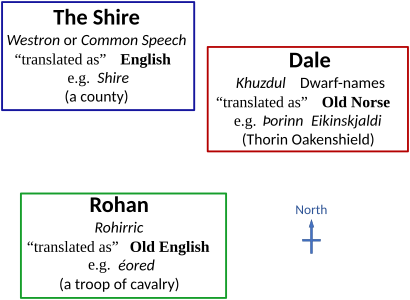Rohan, Middle-earth facts for kids
Quick facts for kids Rohan |
|
|---|---|
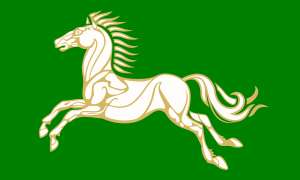
Artist's impression of the flag of Rohan
|
|
| Middle-earth location | |
| Other name(s) | the Riddermark, Calenardhon, the Mark |
| Type | Adopted home of the Rohirrim |
| Ruler | Kings of Rohan |
| Notable locations | Edoras, Dunharrow, Helm's Deep |
| First appearance | The Two Towers |
| Lifespan | Founded T.A. 2510 |
| Founder | Eorl the Young |
| Capital | Aldburg, then Edoras |
Rohan is a make-believe kingdom in J. R. R. Tolkien's fantasy world, Middle-earth. It is home to a group of people known as the Rohirrim. This kingdom is famous for its amazing horse riders. The Rohirrim often help their friends in Gondor with their strong cavalry (horse armies).
Most of Rohan is covered in wide, green grasslands. The Rohirrim call their home "the Mark" or "the Riddermark". These names remind us of an old kingdom in England called Mercia, where Tolkien lived. Tolkien got many ideas for Rohan from old English history and poems, especially from the Anglo-Saxons. He even used Old English words for the names and language of Rohan, pretending it was a translation. For example, Meduseld, King Théoden's great hall, is like Heorot from the famous poem Beowulf.
In The Lord of the Rings story, Rohan is super important! They fight against the evil wizard Saruman in the Battle of the Hornburg. Later, King Théoden leads his horsemen to a huge victory against Mordor's armies in the Battle of the Pelennor Fields. Théoden is sadly killed when his horse falls. But his brave niece, Éowyn, defeats the leader of the Ringwraiths.
Rohan in Tolkien's Stories
What Does "Rohan" Mean?
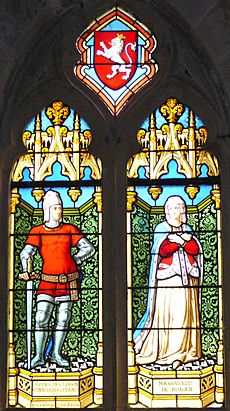
Tolkien explained where the name Rohan came from. In his stories, "Rohan" comes from an Elvish word *rokkō, which means "swift horse for riding". It also has a suffix often used for names of lands.
In real life, Tolkien knew that "Rohan" is a famous name from Brittany, France. It belongs to an old, powerful family. He liked how the name sounded. He then made it fit into his Elvish languages. He said the history of the real Rohan family has nothing to do with the Rohirrim.
Where is Rohan Located?
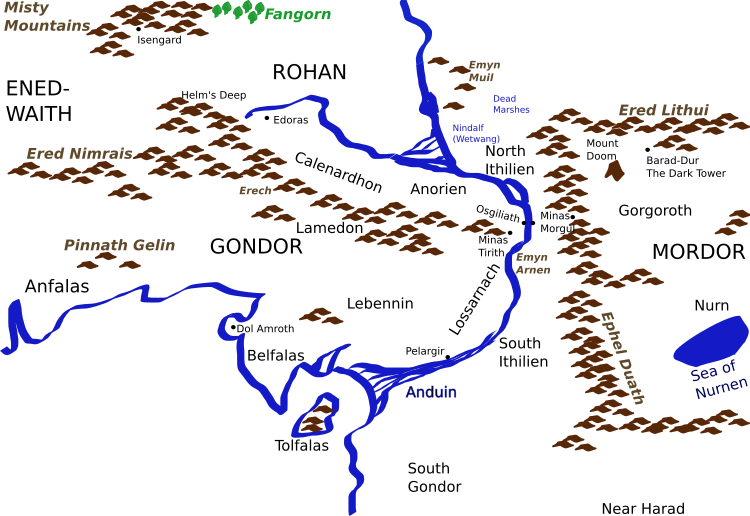
In Tolkien's Middle-earth, Rohan is a landlocked kingdom. This means it has no coastlines. It is described as a place with lots of pastures and tall, green grasslands. The fields are often windy. They have many hidden pools and wet, tricky bogs that water the grasses. One mapmaker, Karen Wynn Fonstad, figured Rohan is about 52,763 square miles. This is a bit bigger than England!
Rohan's Borders
Rohan has many neighbors. To the north, it borders the Fangorn forest. This forest is home to the Ents, who are giant tree-like creatures led by Treebeard. The great river Anduin, also called Langflood by the Rohirrim, is also to the north. The walls of Emyn Muil are to the northeast. After the War of the Ring, Rohan grew northwards. It now reaches the borders of Lothlórien.
To the east are the mouths of the River Entwash. The Mering Stream also forms a border. This stream separates Rohan from a part of Gondor called Anórien. The Rohirrim call this area Sunlending. To the south are the White Mountains, known as Ered Nimrais. To the west are the rivers Adorn and Isen. Here, Rohan borders the land of the Dunlendings.
To the northwest, near the Misty Mountains, is the walled area of Isengard. This area has the old tower of Orthanc. During the War of the Ring, the evil wizard Saruman took over Isengard. The area where the Misty Mountains and White Mountains get close is called the Gap of Rohan.
Rohan's Capital City
The capital city of Rohan is Edoras. It is a fortified town built on a hill. This hill is in a valley of the White Mountains. The name "Edoras" means "enclosures" in Old English. Rohan's second King, Brego, built the town of Edoras. He was the son of Eorl the Young. The hill where Edoras stands is at the entrance to the Harrowdale valley. The Snowbourn river flows past the town on its way east. A tall timber wall protects the town.
Meduseld, the Golden Hall of the Kings of Rohan, is in the center of Edoras. It sits at the top of the hill. "Meduseld" means "mead hall" in Old English. It is based on the mead hall Heorot from the poem Beowulf. Meduseld is a large hall with a thatched roof. It looks golden from far away. The walls inside are decorated with tapestries. These tapestries show the history and legends of the Rohirrim. It is a home for the King and his family. It is also a meeting place for the King and his advisors. And it's a hall for ceremonies and parties. This is where Aragorn, Gimli, Legolas, and Gandalf meet King Théoden.
Other Towns and Regions
Further into Harrowdale, past Edoras, are the small villages of Upbourn and Underharrow. At the top of Dunharrow is a safe place called Firienfeld. This is in the White Mountains. Aldburg is the capital of the Eastfold. It was the first place settled by Eorl the Young. The Hornburg is a big fortress. It guards the western part of Rohan. It is in Helm's Deep, a valley in the White Mountains.
The kingdom of Rohan, also called the Mark, is split into two main parts: the East-mark and the West-mark. Each is led by a marshal. Edoras, Rohan's capital, is in a small but busy area called the Folde. This is in the south-central part of the kingdom. Most of Rohan's people live along the foothills of the White Mountains.
The center of Rohan is a large plain. The Entwash river divides it into the East Emnet and the West Emnet. These areas belong to the East-mark and West-mark. The Wold is the northernmost part of Rohan. It has the fewest people. The Field of Celebrant is even further north. It was added to Rohan after the War of the Ring.
Rohan's Culture
The People of Rohan
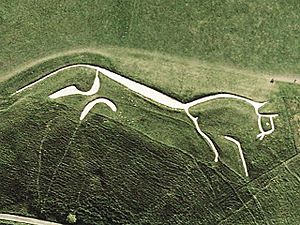
The people of Gondor, called the Dúnedain, and the Rohirrim are related. They came from the same ancestors a long time ago. But the Rohirrim are shown as being less advanced than the people of Gondor.
Many parts of Rohirric culture come from Germanic cultures. This includes the Anglo-Saxons and their Old English language. Tolkien really liked this language. Some experts think the Rohirrim are Tolkien's idea of an Anglo-Saxon society. One that could have fought off invaders with their horse culture. The symbol of the House of Éorl is a "white horse upon green." This might come from the Uffington White Horse. This is a giant horse carved into a chalk hill in England.

Tolkien said that the Rohirrim were not "medieval" in the way we think of it. He wrote that the styles in the Bayeux Tapestry fit them well. This tapestry shows scenes from the Norman Conquest of England.
Horses and Warfare
The armies of Rohan were mostly horsemen. Their main fighting group was called an éored. This Old English word means "a unit of cavalry." During the War of the Ring, an éored had about 120 riders.
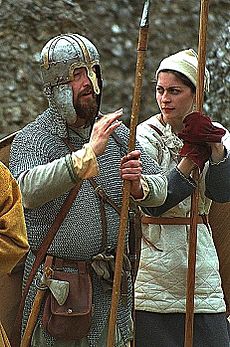
In times of war, every able man had to join the Muster of Rohan. Rohan had promised to help Gondor when needed. This promise was called the Oath of Éorl. Gondor would ask for help by sending a Red Arrow. This is like an old English poem where an arrow was sent as a "token of war." Gondor could also call the Rohirrim by lighting warning beacons. These were seven signal fires along the White Mountains. They stretched from Minas Tirith to the Rohan border.
At the start of the War of the Ring, a full Muster would have been over 12,000 riders. Among Rohan's horses were the famous mearas. These were the noblest and fastest horses in all of Arda. The Rohirrim were very close to their horses. This is why they got their name. Rohirrim means "Horse-lords" in Sindarin. Rohan means "Land of the Horse-lords."
Rohan's Language
Tolkien usually called their language "the language of Rohan." Sometimes he used "Rohirric." Like many languages of Men, it is related to Westron, the Common Speech.
The Rohirrim called their homeland the Riddermark. This is Tolkien's modern version of an Old English word. It means "the border country of the knights." They also called it Éo-marc, the Horse-mark, or simply the Mark. They called themselves the Éorlingas, meaning the Sons of Éorl.
Tolkien made the Rohirric language sound like the Mercian dialect of Old English. Even English words in the books showed a strong Old English feel. Tolkien, who studied languages, pretended that these Old English words were translations from Rohirric. Just like the English used in The Shire was supposedly translated from Westron. Examples include éored (cavalry unit) and mearas (horses).
In The Two Towers, Aragorn sings a song in the language of the Rohirrim. It is called the Lament of the Rohirrim. It sounds sad and old. Tolkien based this song on an Old English poem called The Wanderer. It uses a style called Ubi sunt, which means "Where are they?"
| The Wanderer (Old English) |
The Wanderer (Modern English) |
Lament of the Rohirrim by J. R. R. Tolkien |
|---|---|---|
| Hwær cwom mearg? Hwær cwom mago? Hwær cwom maþþumgyfa? Hwær cwom symbla gesetu? Hwær sindon seledreamas? Eala beorht bune! Eala byrnwiga! Eala þeodnes þrym! Hu seo þrag gewat, genap under nihthelm, swa heo no wære. |
Where is the horse? where the rider? Where the giver of treasure? Where are the seats at the feast? Where are the revels in the hall? Alas for the bright cup! Alas for the mailed warrior! Alas for the splendour of the prince! How that time has passed away, dark under the cover of night, as if it had never been. |
Where now the horse and the rider? Where is the horn that was blowing? Where is the helm and the hauberk, and the bright hair flowing? Where is the hand on the harp-string, and the red fire glowing? Where is the spring and the harvest and the tall corn growing? They have passed like rain on the mountain, like a wind in the meadow; The days have gone down in the West behind the hills into shadow. Who shall gather the smoke of the dead wood burning? Or behold the flowing years from the Sea returning? |
Aragorn explains that this song was sung by a forgotten poet in Rohan. It remembers how great Eorl the Young was.
Rohan's History
Early Days of Rohan
In the 13th century of the Third Age, the Kings of Gondor made strong friendships with the Northmen of Rhovanion. These people were related to the Three Houses of Men from the First Age. In the 21st century, a group of these Northmen, called the Éothéod, moved. They went from the valleys of Anduin to the northwest of Mirkwood. They fought with the Dwarves over a dragon's treasure.
In 2509, Cirion, the Steward of Gondor, asked the Éothéod for help. He needed them to fight off invaders from Rhûn and Orcs from Mordor. Eorl the Young, the leader of the Éothéod, answered the call. He arrived unexpectedly at a big battle on the Field of Celebrant. His arrival helped defeat the orc army. As a reward, Éorl was given a part of Gondor called Calenardhon.
The Kingdom of Rohan is Born

Eorl the Young then founded the Kingdom of Rohan in Calenardhon. His family was known as the House of Eorl. The first line of kings ruled for 249 years. This lasted until the ninth king, Helm Hammerhand, died. His sons had been killed earlier. So, his nephew Fréaláf Hildeson started the second line of kings. This line ruled until the end of the Third Age. The kings are buried in two lines of grave mounds below the royal hall at Edoras. These are like old burial sites in Sweden or England.
In 2758, Rohan was attacked by Dunlendings. Their leader was Wulf, who had mixed Dunland and Rohan blood. King Helm Hammerhand took shelter in the Hornburg. Help from Gondor and Dunharrow arrived a year later. Soon after, Saruman took over Isengard. He was welcomed as a friend at first.
The War of the Ring
Saruman used his power through the traitor Grima Wormtongue to weaken King Théoden. Then, Saruman launched an invasion of Rohan. He won early battles at the Fords of Isen. Théoden's son, Théodred, was killed there. Saruman was defeated at the Battle of the Hornburg. Tree-like creatures called Huorns came from Fangorn forest to help the Rohirrim.
Théoden then rode with his army to Minas Tirith. They helped break the siege in the Battle of the Pelennor Fields. Théoden killed the leader of the Haradrim. But he was killed when his horse fell. His nephew Éomer became the new king. Théoden's niece Éowyn and the hobbit Merry Brandybuck killed the Lord of the Nazgûl.
Éomer rode with the armies of Gondor to the Black Gate of Mordor. He fought in the Battle of the Morannon against Sauron's forces. At this time, the Ruling Ring was destroyed in Mount Doom. This ended the battle and the war. Éowyn married Faramir, the Prince of Ithilien.
Rohan in Movies
For Peter Jackson's The Lord of the Rings movies, Rohan scenes were filmed in New Zealand. The music theme for Rohan is played on a Hardanger fiddle. A full set for Edoras was built on Mount Sunday in New Zealand. Some of the set was made digitally. But the main buildings on top of the city were built in real life. The mountains in the background were part of the actual filming location. The inside of buildings, like the Golden Hall, were built on soundstages elsewhere. The filming site was very windy. After filming, Mount Sunday was returned to its natural state.
Images for kids
-
This stained-glass window shows Marguerite de Rohan. Tolkien said his Rohan was not linked to this noble family, but he liked the name.
-
This map shows part of Middle-earth. Rohan is in the top center, below the Misty Mountains and Fangorn forest. It is west of the River Anduin.
-
The Uffington White Horse is carved into a hillside in England. It may have inspired the Rohirrim's emblem: a "white horse upon green."
-
Tolkien said the styles in the Bayeux Tapestry fit the Rohirrim "well enough."
-
This shows Anglo-Saxon weapons and chainmail armor.
-
These are Viking royal grave mounds at Gamla Uppsala. They are like the burial mounds at Edoras.
See also
 In Spanish: Rohan para niños
In Spanish: Rohan para niños


